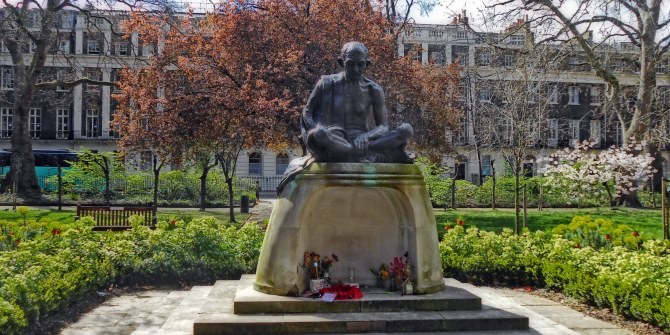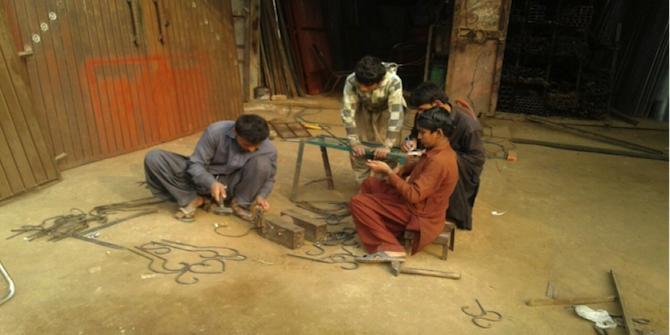LSE’s Sivaramjani Thambisetty analyses India’s copyright law and the potential impact of a ‘fair use’ case on access to educational materials in the country.
August was not a good month for the ‘right to education’ across the world. Iran banned women from attending certain courses, the UK Border Agency’s revoked London Metropolitan University’s visa licensing authority, leaving many foreign students in the lurch, and in India, Oxford and Cambridge University Presses and Taylor Francis publishers took to task both Delhi University and a small shop offering photocopying services for allowing students to ‘illegally’ copy educational material.
An overwhelming majority of young people who pass through the university system in India, myself included, owe much to tiny shops such as Rameshwari Photocopy Services. Students at Delhi Universityare threatening to boycott all books published by the three academic publishers, and there are concerns in the mainstream media that this case has the potential to be Indian copyright law’s ‘London Met moment’.
The case filed alleges that the Ratan Tata Library at Delhi University and Rameshwari Photocopy Services had a relationship whereby course packs with infringing photocopies were produced for students. An agency relationship between the library and the shop is implied—the library specified the price and nature of services. The publishers have sought inflated damages of six million rupees in what promises to be an outlier for more stringent enforcement of copyright laws on university and university-associated premises. Photocopiers and shops in other jurisdictions (notably a small copy shop in Ann Arbor, Michigan, in Princeton Univ. v. Michigan Document Servs 99 F.3d 1381 (6th Cir. 1996) and an Australian University in University of NSW v. Moorehouse (1975) 133 CLR 1) have played the role of the canary in a coal mine. This case too is likely to have far reaching impact on access to educational materials in India.
The law in both the UK and the US requires quantitative limits to copying as an aspect of ‘fair’ copying for educational purposes. In the US the interpretation of ‘fair use’ means that permission from the publisher is required for copying even in an educational context, and to compensate for lost licensing revenues. Publishers grant ‘clearances’ for course packs, whereby for a fee, and for a limited duration, books and articles may be copied and distributed. Fees vary between approximately 8 to 10 cents per copied page, a cost that is usually absorbed by the student.
In the UK, under fair dealing laws we use the UK Higher Education Institutions Copyright License, the terms of which are familiar to most of us teaching at the LSE, perhaps to a greater degree than we would strictly like. The license limits the extent of legal copying of academic materials for the use of students, digitally and otherwise, to whichever is the greater of five per cent of the total text or one chapter of a book, one article of a journal issue, one paper of a set of conference proceedings, one report of a single case from a report of judicial proceedings, etc.
Indian law enumerates several exceptions to the application of copyright, and there are at least two within Section 52 of the Copyright Act that could apply to the current case. The law allows for 1) the ‘reproduction of any work by a teacher or a pupil in the course of instruction’ or as a part of questions or answers to questions, and 2) fair dealing with any work (except computer programmes) for the purposes of private or personal use, including research.
Remarkably, the first exception does not mandate that reproduction amount to ‘fair dealing’ referring instead only to ‘reproduction’, unlike several other provisions within the same Section 52. Eschewing quantitative limits on the extent of copying by a teacher or a pupil sets up a very strong legal basis for the copying that is alleged to have taken place in Rameshwari Photocopy Services. What remains to be seen is whether Delhi Universitycan be defined as ‘teacher’ or whether multiple copies made in commercial quantities by an agent can fall within this provision. This case may result in changes to how course packs are produced and paid for by students, but more importantly presents an opportunity to signal the legality of copying per se by ‘teachers’ and ‘pupils’ in the context of learning and instruction.
Meanwhile, it is worth taking stock of the extent of potential copyright infringement in India, specifically with respect to educational materials. It is not uncommon for college libraries to make full versions of photocopied textbooks available on their shelves along with originals to cater to student numbers. Typical course readings for postgraduate courses or professional courses will include multiple readings from a number of foreign published books, not all of which may be available even in the best libraries.
At my alma mater there were no originals of volumes such as Hayek’s “Constitution of Liberty” or T.H. Green’s “Lectures on Political Obligation”—we assumed that our lecturers used the originals while we had to suffice with hard-bound photocopies. After all, a typical £30 textbook would cost 2,300 rupees at today’s conversion rate. Compare this to Delhi University’s fees, which average 10,000 rupees per year for a B.A. (Hons) course. Putting that in a UK context, where annual tuition fees are £9000, that’s the equivalent of students paying £2070 for a single textbook.
Higher education institution licenses in the UK and course pack clearances in the US are based broadly on a bid to compensate publishers for lost revenue. However, given the relative cost of much of the educational material published outside of India, one could argue that the prohibitive price for Indian students does not actually translate to realistic sales and therefore cannot lead to ‘lost’ revenue. Many publishers also claim that lower priced editions of most books are available to the Indian market, but one study of legal textbooks reports the claim to be unfounded.
There is no doubt that the global publishing industry faces several challenges, including open access initiatives and digitisation projects. Looking to enforce intellectual property rights in emerging markets is a tried and tested method for corporations to diversify incomes, as we have seen in the case of patents and pharmaceuticals. Access to affordable education in India is a vital part of its growth and development projections, and mandated by several interpretations of the constitutional right to life.
While the Delhi High court will be looking to make a distinction between course packs and other educational material, it will also need to address the extent of permissible copying for research or personal use outside of course packs. This would be a good juncture for universities, civil society organisations, and university publishers in India to begin formulating the terms of a higher education license.
In light of the poor cross-subsidisation of textbooks in India, the unreality of ‘lost revenue’ from the sale of prohibitively priced books, and the strategic difficulty of policing enforcement, I suggest that the extent of permissible copying be set generously and well in excess of the five to 10 per cent common in other jurisdictions. Professor Shamnad Basheer at the National University of Juridical Sciences proposes 20 per cent as appropriate. Once the publishing sector can show greater evidence of making lower priced and up-to-date editions available to the Indian market, the terms can perhaps be revised.
As corporations go, university publishers are a special class who may represent antagonistic interests in the case of academic authors. In arguments submitted in a class-action lawsuit over Google’s vast book-scanning project, Professor Pamela Samuelson at the University of California wrote that almost by definition, academic authors “are committed to maximising access to knowledge”, while publishers by contrast “are institutionally committed to maximising profits”. It would be invaluable if UK and US textbook authors had the capacity to negotiate terms with their publishers that narrow the interest gap between access to knowledge in developing countries and the maximisation of profits.
Although I believe that this particular canary in Delhi will survive, the ideal of aligning the interests and values of scholarly authors and the publishing industry is unlikely to be realised.
For a more thorough legal analysis see Kafila and SpicyIP.
Sivaramjani Thambisetty is an intellectual property lawyer who teaches and researches on patent law, emerging technologies, innovation and legal institutions. Siva is also Regional Champion for India at the LSE.








